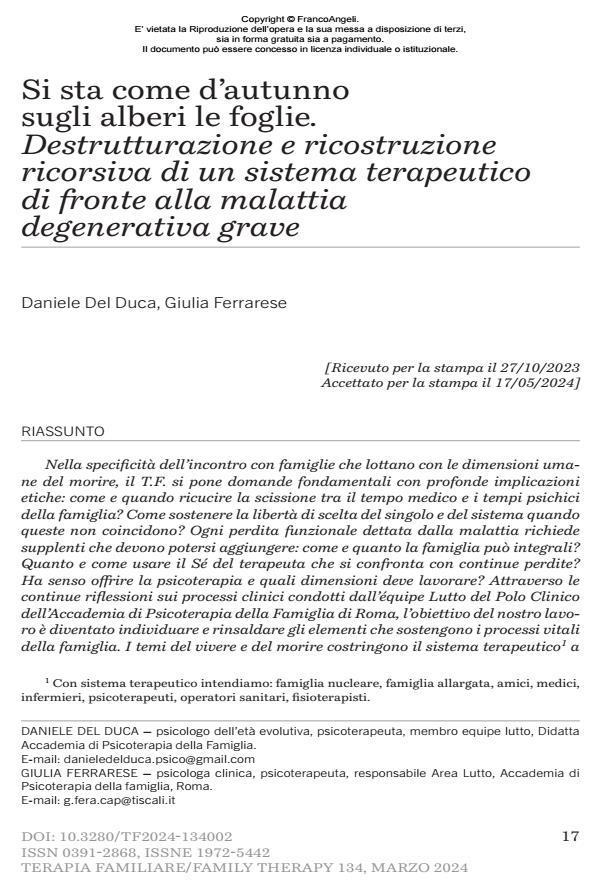Si sta come d’autunno sugli alberi le foglie. Recursive reconstruction of a therapeutic system facing severe degenerative disease
Journal title TERAPIA FAMILIARE
Author/s Daniele Del Duca, Giulia Ferrarese
Publishing Year 2024 Issue 2024/134
Language Italian Pages 16 P. 17-32 File size 649 KB
DOI 10.3280/TF2024-134002
DOI is like a bar code for intellectual property: to have more infomation
click here
Below, you can see the article first page
If you want to buy this article in PDF format, you can do it, following the instructions to buy download credits

FrancoAngeli is member of Publishers International Linking Association, Inc (PILA), a not-for-profit association which run the CrossRef service enabling links to and from online scholarly content.
When encountering a family struggling with the human dimensions of dying, the family therapist cannot help but ask himself fundamental questions with profound ethical implications: how and when it is best to mend the split between medical time and the psychic times of the family? How can we support the freedom of choice both of the individual and the system when these do not coincide? Every functional loss dictated by the disease requires more caregivers and equipment which must be added: how and to what extent can the family integrate them? How can the therapist manage the Use of Self when dealing with constant losses? Does it make sense to offer psychotherapy, and on what dimensions does it have to work? Through the reflections on the clinical processes conducted by the Mourning team of the Clinical Center of the Accademia di psicoterapia della famiglia in Rome, the goal of our work has become to identify and strengthen the elements that allow the therapeutic system to keep on working with the vital processes of the family. The unsettling process of dying force the therapeutic system – which in our thinking includes enlarged family, friends and therapists – into continuous adaptive change; only by tolerating impotence and be willing to learn from this painful experience can the destructuring loss also became an opportunity to reconstruct new ways of communicating, of being, of living. Rebuilding relationships, seeking and fortifying intact resources, working on the meanings of Time and the conscious choice of how to live it, are the core of our clinical work. The therapeutic relationship is the elective place of this process of mutual learning that allows the family to know and recognize each other even within the new boundaries imposed by the disease and lead the therapists towards new edges of themselves and of what can be considered therapeutic.
Keywords: loss; adaptation; rebuilding; choice; ethics; relationship
Daniele Del Duca, Giulia Ferrarese, Si sta come d’autunno sugli alberi le foglie. Destrutturazione e ricostruzione ricorsiva di un sistema terapeutico di fronte alla malattia degenerativa grave in "TERAPIA FAMILIARE" 134/2024, pp 17-32, DOI: 10.3280/TF2024-134002